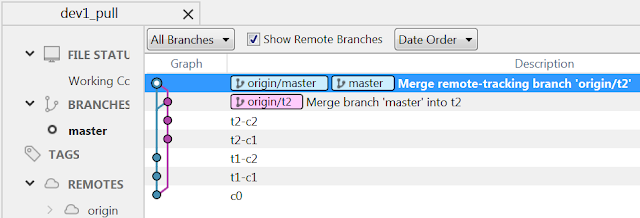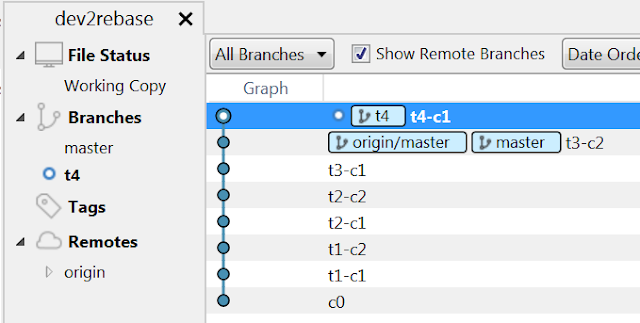Continue our
theme, dev1 is still the lucky
hero, in this tutorial, dev2 is
allowed to merge his code directly into master,
he has to create pull request to ask dev1 to pull his code into master. Let us see what kind of troubles he will run
into.
Day 1 end
dev1 pushes his code into remote
dev1 is happy with his changes and
push to the remote master:
git checkout master
git merge t1
git push -v --tags --set-upstream origin
master:master
git branch --delete t1
dev2 creates a pull request
dev2 wants to ask dev1 to pull his code into master, to
do so, he does these things:
1) merge
master into his branch, and as we know by now, he runs into a conflict and
solves it
git checkout master
git pull origin master
git checkout t2
#runs into a conflict
git merge master
#solves the conflict
git add testf
git commit
2) push
his local branch to remote, in doing so, creates a remote branch with the same
name
git push -v --tags --set-upstream origin t2
At this point, dev2’s workspace looks like this:
3)
creates a pull request
hub pull-request -m "p1"
Note, hub is an extension of github commands,
and can be downloaded from https://github.com/github/hub,
to install it in windows, just add the bin
directory to the PATH variable.
Now you can
see in Github, an open pull request, which, since dev2 has taken care to solve
conflict first, can be auto merged:
What will happen if dev2 doesn’t merge first? In other words, dev2 doesn’t do the first step, instead he just does the second and third step:
git push -v --tags --set-upstream origin t2
hub pull-request -m "p1"
Github shows
the result pull request has conflicts, and has to be solved manually:
dev1 merges the pull request
Since there
is no conflict on the pull request, dev1
can merge the request on Github by clicking on the merge button.
In our plot,
dev1 doesn’t trust dev2 very much, perhaps because dev2 is an open source contributor who
is unknown to dev1, so dev1 decides to merge dev2’s code locally to check out. He
can merge the remote t2 into his
local master and then push his
local master to remote:
git checkout master
git pull origin master
#note, need to fetch origin
first, otherwise git will complain origin/t2 is unknown
git fetch origin
git merge --no-ff origin/t2
git push -v --tags --set-upstream origin
master:master
Or he can
check out the remote t2 into a
local branch, and merge the local branch to his local master, then push his local master to remote:
git checkout master
git pull origin master
git fetch origin
git branch t2 origin/t2
git merge --no-ff t2
git push -v --tags --set-upstream origin
master:master
Either way, dev1 ends with:
Going to
Github, you will see the pull request has been merged:
Day 2
dev1 pushes his code into remote
dev1 works on a local branch t3, and pushes his changes to remote:
git checkout master
git pull origin master
git checkout t3
echo 't3-c1' >> testf; git add testf;
git commit -m 't3-c1'
echo 't3-c2' >> testf1; git add testf1;
git commit -m 't3-c2'
git checkout master
git pull origin master
git merge t3
git push -v --tags --set-upstream origin
master:master
git branch --delete t3
dev2 creates a pull request
git checkout master
git pull origin master
git checkout -b t4
echo 't4-c1' >> testf; git add testf; git commit -m 't4-c1'
git push -v --tags --set-upstream origin t4
hub pull-request -m "p2"
At this
point, the pull request contains no conflict, and can be auto merged. Unfortunately,
dev1 feels too tired, and he
returns home without noticing the pull request.
Day 3
dev1 pushes his code into remote
dev1 doesn’t pay attention to dev2’s pull request, he chooses to
work on his stuff first:
git checkout master
git pull origin master
git checkout -b t5
echo 't5-c1'>> testf; git add testf;
git commit -m 't5-c1'
Note, at
this point, the pull request created in day 2 now contains conflicts!
dev2 creates a pull request
dev2 continues to work on his local
branch t4, then tries to merge t4 with remote master, upon which he runs into a conflict which he
solves manually:
git checkout t4
echo 't4-c2' >> testf; git add testf; git commit -m 't4-c2'
git checkout master
git pull origin master
git checkout t4
git merge master
#solve the conflict
git add testf
git commit
Then he
pushes his local t4 to remote:
git push -v --tags --set-upstream origin t4
Now, notice
the pull request created in day 2 has no conflict again, because the conflict
has been solved by dev2!
dev2 tries to create a new pull
request:
hub pull-request -m "p3"
This is not
necessary and will actually fail with the message:
Error creating pull request: Unprocessable
Entity (HTTP 422)
A pull request already exists for t4.
dev1 merges the pull request
Finally, dev1 has some free time and is able to merge the pull
request:
git checkout master
git pull origin master
git fetch origin
git merge --no-ff origin/t4
git push -v --tags --set-upstream origin
master:master
dev1’s workspace now looks like this:
Lessons
learned:
- To make sure a team functions smoothly, pull requests should be merged quickly.
- Solving conflicts is a chore, and it should be avoided as much as possible. In any day, well-designed code (loosely-coupling code) is the king.




















